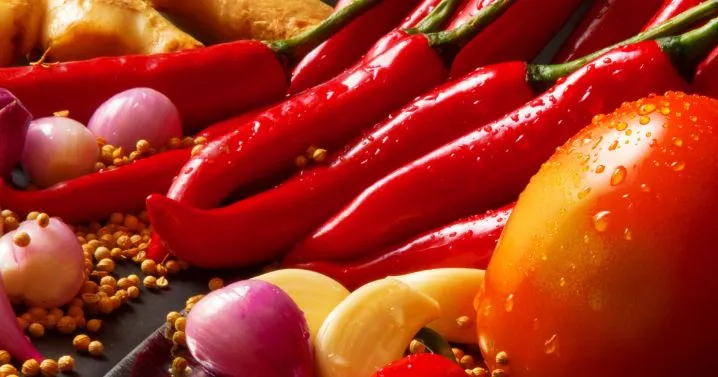
Spice, or the perception of it, is present in most cuisines around the world. Genus Capsicum (family of Solanacease) is used in thousands of recipes and sometimes eaten as a dish in itself. One in four people on the planet eats it every day.
As a forest ecophysiologist, I study the adaptive characteristics developed by plant organisms to interact with other organisms and the surrounding environment.
The research on peppers and heat is a perfect example of multidisciplinary science. Over the past decades, several scientists have provided information and talked about the particularities of this unique and sought-after sensation.
Brief history
Chili peppers were unknown to much of the world until Christopher Columbus reached the New World in 1492. Several theories have named various places in South America as “the” place of origin for chili peppers.
Phylogenetic analysis has revealed that they originate from an area that borders the Andes, from west to northwest South America. These ancestral wild Capsicum were “small, round, berry-like red fruits” .
The first traces of domestication date from 6,000 years ago in Mexico or northern Central America. Peppers were introduced to Europe in the 16th century. Today there are five species of cultivated peppers.
These five species are Capsicum annuum , C. chinense , C. frutescens , C. baccatum , and C. pubescens . The one with the most varieties is C. annuum , which includes the New Mexico jalapeño and the sweet pepper (or capsicum). Habaneros and Scotch peppers belong to the species C. chinense , while tabasco peppers are C. frutescens . South American ajis are part of C. baccatum . C. pubescens include Peruvian rocotos and Mexican manzanos.
Today, more than three million tons of peppers are produced each year, for a global market that is well over $4 billion .

Why does the pepper burn?
Pungency is a burning sensation caused by capsaicin in food. When eating spicy foods, capsaicin stimulates TRPV1 receptors, located in the mouth, and triggers a reaction.
When capsaicin activates the TRPV1 receptors, the sensation one experiences resembles that which one feels when one is in contact with something hot, close to the boiling point of water. However, our confused neural receptors create an illusion of pain because of spices – there’s nothing really “hot” about spicy food.
All Peppers Are Equally Spice?
Not all peppers are equally spicy. In 1912, pharmacist Wilbur Scoville created a scale to measure the pungency of chili peppers. This scale, measured in Scoville Heat Units (SHU), is based on the reaction to capsaicinoids, which occurs when eating hot peppers.
On the Scoville heat scale, peppers (SHU of 0) are at the bottom of the scale. Jalapeño peppers can range from 2,500 to 10,000 units.
Tabasco peppers are rated at 25,000 to 50,000 units, compared to habanero peppers at 100,000 to 350,000.
The hottest pepper in the world – the Carolina Reaper (or Carolina Reaper) – reaches 2.2 million units. Bear repellent – with 2% capsaicin – hits 3.3 million units, and pure capsaicin hits 16 million, at the top of the Scoville scale.
A human pleasure
Psychologist Paul Bloom wrote:
Philosophers have often looked for the characteristic that defines humans – language, rationality, culture, etc. I would say for my part: humans are the only animal to like Tabasco sauce .
YouTube show “Hot Ones” features interviewed celebrities eating spicy chicken wings.
Bloom is right. While no animal likes peppers, we are not the only animal species to eat them. Mammals, such as mice and squirrels, have the same pungent food receptors as humans, and they avoid hot peppers as a food source.
Birds eat hot peppers, but they do not perceive a sensation of heat. Their receptors are different from ours, which makes them biologically unable to register the effects of capsaicin.
It is difficult to know what caused the evolution of capsaicin. Some say it is an adaptation to select birds as consumers of chili peppers. Birds do not chew or digest seeds as rodents do, and they carry them very far.
Other studies indicate that capsaicin is an effective compound against parasitic fungi and that the sensation of heat is only a side effect in mammals.
Some experts claim that we love chili peppers because they are good for us. They would have beneficial effects on human health. They reduce blood pressure and may have antimicrobial effects. The pain from chili peppers can even be overwhelming and help manage other pains.
According to another hypothesis, it would be a benign form of masochism. Psychologist Paul Rozin suggests that it provides a pleasurable sensation, similar to the pleasure experienced on a roller coaster. In an interview, he explains:
The mind dominates the body. My body thinks I’m in danger, but I know I’m not .
Reduce burn
What happens when a portion of food is so spicy it’s hard to bear? Researchers have tested the ability of various beverages to calm the fire or reduce oral burning caused by capsaicin.
A glass of water has no effect on capsaicin because it is hydrophobic – its molecule does not bind to water. Although it remains to be proven, the ethanol contained in a cold beer could even increase the burning sensation.
Drinks with a significant amount of sugar can soothe because the activation of the perception of sweetness disconcerts our brain. With too many stimuli to handle, the sensation of spiciness is reduced.
A glass of milk or a few spoonfuls of yogurt or ice cream soothe the burn. These products are usually sweet, but there is more: casein – the main protein in cow’s milk – attracts capsaicin molecules. The casein molecules surround the capsaicin molecules and wash them away, the same way soap washes away fats.
So, the next time you want to try a new sauce or a spicy dish, don’t forget to accompany it with a glass of milk.
Want to know more about new recipes, read about Jolof rice.